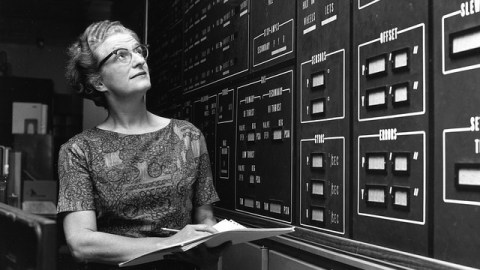NASA renames telescope after ‘Mother of Hubble’ Nancy Grace Roman

NASA
Announced earlier today, NASA has renamed the Wide Field Survey Telescope (WFIRST) in honor of Dr. Nancy Grace Roman, who helped make space-based telescopes a reality as the agency’s first female executive.
The Nancy Grace Roman Space Telescope (or Roman Space Telescope, for short) will help scientists study dark energy, search for and image distant exoplanets, measure cosmic acceleration and generate massive panoramas of the universe. It’s set to launch in the mid-2020s.
“It is fitting that as we celebrate the 100th anniversary of women’s suffrage, NASA has announced the name of their new WFIRST telescope in honor of Dr. Nancy Roman, the Mother of Hubble – well deserved,” said Former Sen. Barbara Mikulski, who worked with NASA on the Hubble and WFIRST space telescopes. “It recognizes the incredible achievements of women in science and moves us even closer to no more hidden figures and no more hidden galaxies.”
I'm proud to announce that we've renamed our WFIRST mission to the Nancy Grace Roman Space Telescope. Her leadership enabled NASA to become a pioneer in astrophysics. This mission will honor its namesake by transforming our view of the cosmos: https://t.co/qqPKD46PY3 pic.twitter.com/tYJmpoDtIo
— Jim Bridenstine (@JimBridenstine) May 20, 2020
I’m proud to announce that we’ve renamed our WFIRST mission to the Nancy Grace Roman Space Telescope. Her leadership enabled NASA to become a pioneer in astrophysics. This mission will honor its namesake by transforming our view of the cosmos: https://go.nasa.gov/2AJExY9 pic.twitter.com/tYJmpoDtIotwitter.com
“Nancy Grace Roman was a leader and advocate whose dedication contributed to NASA seriously pursuing the field of astrophysics and taking it to new heights,” said Thomas Zurbuchen, NASA’s associate administrator for science. “Her name deserves a place in the heavens she studied and opened for so many.”
Roman was born in Nashville in 1925 and died on December 25, 2018.
In a draft of her memoir, she recalled taking a liking to astronomy at an early age. When she was four, her favorite thing to draw was the Moon, and between the fifth and sixth grades she started an astronomy club with her friends. But she wasn’t quite sure how she first got interested in the cosmos. One possible explanation:
“The northern Michigan town had a dark sky,” she wrote. “There, my mother showed me the constellations and the Northern Lights that were fairly bright in those years.”
But not all adults supported her interests.
“As a girl, I was strongly discouraged from a career in science. Although it was not the first time I was informed of the foolishness of a career in science for a woman, I remember vividly the reaction of my high school guidance counselor when I asked for permission to take a second year of algebra instead of a fifth year of Latin. She looked down her nose at me and sneered, “What lady would take mathematics instead of Latin?” Thanks to Pearl Harbor, the issue became moot. I substituted a summer of chemistry for my senior year and started college a year before I had planned.”
In 1946, Roman earned a bachelor’s degree in astronomy from Swarthmore, and several years later a doctorate from the University of Chicago. Throughout the 1950s, Roman made a name for herself in the astronomical community by publishing several important discoveries about the composition of stars in the Milky Way galaxy. The star that “changed her life,” as she wrote in her memoir, was AG Draconis.
Roman had noticed that this star’s emission spectrum had unexpectedly changed compared to earlier observations, and so she published a two-page note detailing her observation. What she didn’t know was that she happened to observe the star during a very rare state.
“Parenthetically, we now know that the star that changed my life is in the unusual state in which I found it for only about 100 days every 10 or 15 years or so,” she wrote. “Finding it was a stroke of luck. But equally important was that I recognized that it was interesting, and that I took advantage of the opportunities that my stroke of luck brought my way.”
In 1959, NASA recruited Roman as Chief of Astronomy in the Office of Space Science, where her main focus was managing astronomy-related grants. She was the agency’s first female executive.
Nancy Grace Roman Mother of the Hubble Telescopeyoutu.be
“I knew that taking on this responsibility would mean that I could no longer do research, but the challenge of formulating a program from scratch that I believed would influence astronomy for decades to come was too great to resist,” she said in a NASA interview.
She began “planning a program of satellites and rockets with the advice of a wide sample of the nation’s astronomical community,” as she described to NASA. Roman said the space agency was a great place to work in the its first years.
“Most of the professional staff in Headquarters was composed of the cream of engineers from the NACA. Everyone was gung ho. There was no bureaucracy. Furthermore, the priority of the Apollo program made money less tight. Once, I wanted to do something unusual. I no longer remember what it was, but I called someone in the grants office to find out if I could do it. The reply was memorable: “Don’t ask me what you can do. Tell me what you want to do. It is up to me to find a way.”

Roman Space TelescopeNASA
Roman was instrumental in ushering in the era of space-based telescopes. Between 1966 and 1972, NASA launched four Orbiting Astronomical Observatories into space, two of which were successful. These missions helped pave the way for Roman’s biggest contribution to her field: making the Hubble Space Telescope a reality. Ed Weiler, Hubble’s chief scientist until 1998, called Roman “the mother of the Hubble Space Telescope.”
Roman said that gender discrimination existed in government, but she wasn’t affected by it personally.
“I may have run into a glass ceiling, but I am not sure I had the diplomatic skills for higher office. Robert Zimmerman, in his book about the Hubble Space Telescope, titled The Universe in a Mirror: The Saga of the Hubble Space Telescope and the Visionaries Who Built It, states with reference to me: ‘Her hard-nosed and realistic manner of approving or denying research projects had made her disliked by many in the astronomical community.’ However, I would not have gotten as far as I did if I had not been stubborn. I recognized early that I was not a good diplomat. I tend to state things as I see them without softening my comments. I try to treat everyone equally without attention to prestige or political power.”





